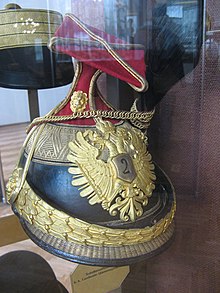Chapka

A Tschapka is a military headgear of Polish origin, which was especially worn by Uhlans . It initially developed as a variant of the shako , which was given a square lid similar to a Konfederatka . Later the Tschapka developed similarly to the contemporary pickel hood , but instead of the tip it had its characteristic square top.
In its early, compact form, the Tschapka was introduced to the Austrian Uhlans from 1784 , which was being set up at the time in the garrisons in Galicia under Habsburg rule . With the Polish legions that fought under French flags in the Napoleonic Wars, the Tschapka also became known outside of Eastern Europe. The Polish Uhlans of Napoleon's Imperial Guard made them extremely popular and not only introduced into France, but also imitated by his allies such as Westphalia and Naples . While in the Grand Duchy of Warsaw and infantry and artillery were equipped with it, use other states, they mostly just for their Lancers.
Even Bavaria , Saxony and Russia possessed cavalry units with this type headgear. After the end of the Napoleonic era in 1815, the Tschapka was still used by the Uhlans in Germany and Austria, and in France by the lancers of the line and later by the Imperial Guard Napoléon III. carried. England introduced it shortly after Waterloo for its Uhlans. With the end of the Second Empire , France also dissolved its Uhlans, so that the Tschapka disappeared from the French army.
German and Austro-Hungarian Uhlans moved with the Tschapka into the First World War , in the course of which, however, it was abolished for the field uniform.
The German or Austro-Hungarian Tschapka consisted of a body pressed from leather and blackened, which was called a cap and was only equipped with a front visor. As the only helmet-like headgear worn by the troops in both countries, the Tschapka had no rear visor, so it ended about halfway up the back of the head. Instead of the point, a special capka neck with a square lid was attached in the middle in such a way that one corner pointed forward. The so-called national ( cockade ) was attached to the left front edge of the lid . Next to it was a sleeve for inserting the hair bush. On the right front edge of the lid there was a hook for attaching the lanyard . The front of the chapka body bore a metal emblem (usually an eagle). For the parade (Germany) a parade discount (cover) in the badge color of the regiment was attached to the Tschapkahals. In Austria-Hungary the Tschapkahals was always lined in the regimental color. In order to give the Tschapka a secure hold on the head, scale chains were attached to both sides on a leather strap, which usually rested on the front umbrella during dismounted duty and were only closed under the chin for riding duty.
In Austria-Hungary there was the so-called Kommode-Tschapka, which consisted of a lighter version without an emblem and which was covered with a layer of oilcloth. This headgear could be worn by officers in the field service. At the start of the war, the Tschapkas should be covered with a cloth cover for camouflage purposes. Since not enough of these covers were available, the Tschapkas were simply painted gray. In the German Reich , team chapkas were made from painted sheet metal or felt after the outbreak of war. With this model, the lid and capkah neck could be removed.
The military musicians of the two British Uhlan regiments (today armored reconnaissance units ) still wear the traditional Tschapka from Victorian times with their parade uniform.
swell
- Army History Museum in Vienna
- Hugo FW Schulz: The Prussian Cavalry Regiments 1913/1914 . Weltbild Verlag 1992.
- Jürgen Kraus, Stefan Rest (Ed.): The German army in the First World War . Ingolstadt 2004.
- Johannes Christoph Allmayer-Beck and Erich Lessing: The KuK Army 1848-1914 . Bertelsmann, Munich 1989, ISBN 3-570-07287-8 .
- Liliane and Fred Funcken: Historical Uniforms in the 18th Century . Mosaik Verlag, Munich 1978.
- Liliane and Fred Funcken: Historical Uniforms in the 19th Century . Orbis Verlag, Munich 1989.

